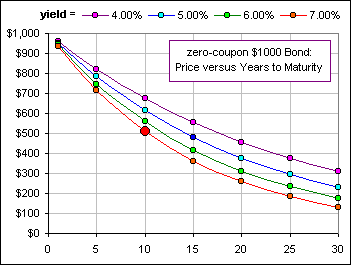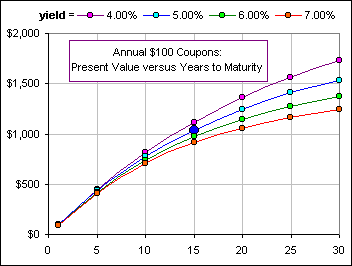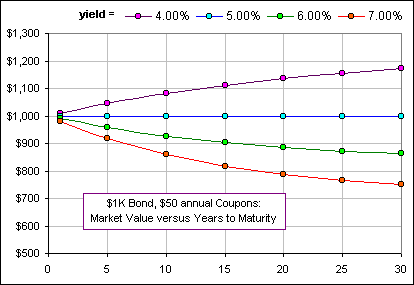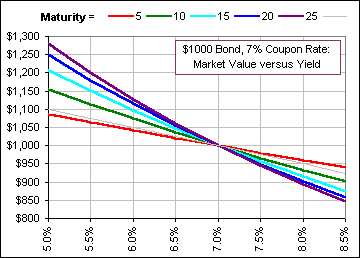| Bonds and stuff |
Here's the problem.
We buy a Bond which matures in 10 years, at which time it pays us $1000.
That's the Face Value or Par Value of the bond.
We want to know how much we should pay for this bond in order to achieve a 7% annual return
(or 7% Yield to Maturity = YTM).
If we pay $A then, after 10 years at 7%, this $A will have grown to A(1.07)10 which
will equal the maturity value of $1000.
This gives A(1.07)10 = 1000 so A = 1000/(1.07)10 = 508.35 meaning that
if we pay this amount we'd be getting a YTM of 7%.
>If we paid less than $508.35 we'd
get a higher YTM! 
Yes.
In general, if:
B is the value at maturity example: A = 1000Remember this Magic Formula. It's the Present Value of the $1000 final value. >A picture is worth a thousand ... Okay, here's a picture  where the above example is indicated with a ... >Big red dot. Yeah, a big red dot. |  Fig. 1 |
>The chart says zero-coupon, but you haven't explained ...
Patience.
Some bonds pay you an annual (or semi-annual) amount called a coupon which is normally
quoted as a percentage of the maturity value of the bond. For example, if the coupon is 5% for
a $1000 bond and the coupon is distributed annually, then you'd get 5% x 1000 = $50.00 each year.
This 5% rate we'll call this the Coupon Rate (and one would call such a bond a "5% bond").
If, however, you paid $900 for this bond, then you'd get
$50 each year and 50/900 is 5.56% which is called the Current Yield ... not to be confused
with the Yield to Maturity!
>The coupons are in addition to the $1000, after ten years.
Yes, if the bond matures in ten years.
>Then that $1000 bond has gotta be worth more than $508.35 because ...
Of course. You'll have to pay, in addition to the zero-coupon value of $508.35 (which
we indicated above) ... you'd have to pay the Present Value
of all those coupons.
>Using that ...
We'll use, of course, that Magic Formula, like so ...
Assume the coupon is worth $C and is paid annually, the first being paid one year from now. Then:
The first coupon has a Present Value of C/(1+R)
The second coupon has a Present Value of C/(1+R)2
The third coupon has a Present Value of C/(1+R)3
...
The Nth coupon has a Present Value of C/(1+R)N
and the sum of all those is
C/(1+R) + C/(1+R)2 + C/(1+R)3 + ... + C/(1+R)N
|
>I assume there's another magic formula. Yes, it's: (2) V = (C/R) { 1 - (1+R)-N}For example: It's a $1000 bond which matures in 15 years and pays an annual 10% coupon. >That's 10% x 1000 = $100 per year. Isn't that a lot? Right. That 10% is the Coupon Yield as opposed to the Yield to Maturity (which involves the present value of all coupons and par value or maturity value of the bond). That's what we're calling R. In what follows, we'll just call R the "yield" and we'll inderstand that we mean YTM (Yield to Maturity).
Anyway, that 10% is just an example. Don't get excited. V = 100/0.05{ 1 - (1.05)-15} = $1037.97 >The big blue dot? |  Fig. 2 |
>Wait! Don't tell me, it's ... uh ... we haven't got the zero-coupon value yet.
Yes. It's ...
>Wait! Don't tell me, it's 1000/1.0515 = $481.02 which we could have read off the first chart, eh?
Yes. It's the small, dark blue dot.
>So we'll have to pay $481.02 + $1037.97 = $1518.99, right?
Yes, but that number changes from day to day as interest rates, hence the yield, changes.
>I assume you have a picture for that, too.
Yes ...

Fig. 3
>Weird. One graph is horizontal.
Yeah. That's where the annual decrease in present value of the zero-coupon bond is exactly
compensated by the annual increase in the present value of the coupons. You'd be buying
such a bond at its par value; $1,000 for a $1K bond.
>That's for a yield of 5%, right?
Right. If the coupon rate is 5%, and so is the current yield to maturity, then you'd buy at par.
Here's a different kind of chart, plotting the Market Value vs Yield with a 7% Coupon:

Fig. 4
Neat, eh? Every graph is at $1,000 for Yield = 7% = Coupon Rate.
Further, long term bonds are more sensitive to the current Yield.
>What if the coupons come twice a year?
Then, in (2), the second magic formula, the number of coupons double and the yield gets halved.
>Halved?
Yes, because it's now the 1/2-year yield. The formula for the coupons is then:
(3) V = (C/R) { 1 - (1+R/2)-2N}where, as before, N is the numbers of years to maturity and R is halved and the exponent changes from -N to -2N and the coupon value (that's C) halved (so C/R stays the same).
Altogether now: the final Magic Formula.
|
Market Value = B { 1/(1+R)N + (Cr/R)
(1 - (1+R/m)-mN)} where N = number of years to maturity Cr = annual Coupon rate m = number of coupons per year B = value of Bond at maturity, R = Annual Yield to Maturity |
|
Using B { 1/(1+R)N + (Cr/R)
(1 - (1+R/m)-mN)}
|
If there's a single annual coupon, so m = 1, then the formula is:
Market Value = B { 1/(1+R)N + (Cr/R)
(1 - (1+R)-N)}
and, if the yield = the coupon rate so R = Cr it becomes:
Market Value = B { 1/(1+R)N +
(1 - (1+R)-N)} = B = par value as we've seen, above.
Another thing:
If we use the approximation: (1+x)n = 1 + nx, we can rewrite the above formula for the Market Value as:
(4) Market Value = B{ 1 + N(Cr - R)} approximatelyand we note that the graph of Market Value versus Yield R is (approximately) a straight line ... as we saw in Fig. 4.
In fact, we could use Equation (4) to estimate the yield: R = Cr + (1 - MktValue/B)/N ... approximately.
>The approximation ... is it any good?
For smaller maturities (meaning smaller values of N) it's okay.
Look carefully at Fig. 4 and next to the 5-year bond you'll see a light grey graph. That's the approximation for N = 5.
>And for a 25 year maturity? How's the approximation?
You don't want to know.
>When you get the coupons, you're assuming that these coupon dollars are re-invested, right? I mean, in order to achieve that YTM.
Yes, at the current yield ... until maturity.
>I still think that formula for the Market Value is complicated and ...
If we buy a bond for $A and assume an annual coupon, worth $C, we can rewrite that formula like so:
A(1+R)N = B + C(1+R)N-1 + C(1+R)N-2 + C(1+R)N-3 + ... + Cwhich means that if we had put the $A in the bank at an annual interest rate of R, then it'd be worth A(1+R)N after N years. That's the left side of the above equation.
On the other hand if we buy the bond, the coupons (if stuck in the bank at the rate R) would give, after N years, an amount:
C(1+R)N-1 + C(1+R)N-2 + C(1+R)N-3 + ... + CIf we add B, the maturity value of the bond, then we'd get the price of the bond. See? Buying the bond for $A is the same as putting our $A in the bank for N years at the current yield R. By the "current yield" I mean, of course, the Yield to Maturity.
>So, what if I don't (or can't) invest the coupons at the yield rate.
What if I buy hamburgers with the coupons. What if ...? >The red dot, in the chart?
>So if I don't reinvest my coupons, my YTM changes, eh?
>My Rate of Return goes down.
>Okay, but how do I measure the sensitivity of bond prices to current
changes in interest rates?
I sure am glad you asked that question:
P.S.
See also Bond Calculators.
>Huh?
>But I always thought that if we get $B in N years, that'd be worth B/(1+R)N today.
>That's the financial convention, right?
In other words, it's the regular-garden-variety present value with the annual gain factor 1+R replaced by (1+R/m)m
>Not much difference, the two prescriptions, eh?
Then the formula above, namely:
A(1+R)N = B +
C(1+R)N-1 +
C(1+R)N-2 +
C(1+R)N-3 + ... + C
would become:
A(1+R)N = B +
C + C + C + ... = B + N C so
R = {(B + N C)/A }(1/N) - 1
>Like putting the coupon monies under the pillow, at 0% interest, eh?
Exactly. For example, if you bought a 10-year $1K bond with annual coupons at the rate 4%
and with (advertised) yield to maturity of 6%, then you'd pay $853 (using the
final Magic Formula, above).
Your return would, in fact, be 6% if you reinvested the annual $40 coupons at 6%. However, if you spent the coupons
at Burger King your actual return would be (for a bond with par value of $1K and
10 coupons at $40 worth $400, where you'd pay $853 and receive $1400 after 10 years):
R = {1400/853 }(1/10) - 1 =
0.051 or 5.1%
The red dot.

The "advertised" YTM assumes reinvestment at the current yield and, if you reinvest at the
yield, it's also your Rate of Return. If you buy hamburgers, the YTM don't hardly change, but ...
Exactly.
I mean, if expected yields go up or down, how do I know whether
it's best to buy a short term bond or a ...?
In case you'd like an estimate of the Yield to Maturity ...
Motivated by email from James Hymas
Financial Conventions
I recently had an interesting conversation with James Hymas.
He pointed out that the formula I provided above for the price of a bond (see in Figure 1) uses
different returns when calculating the present values of the coupons and the bond maturity value.
For m coupons per year, the usual practice is to take R/m as the rate per period.
For a coupon that's received in n years, hence mn periods, the coupon value gets divided by (1+R/m)mn
to generate the present value ... and that's what we used to generate the formula in Figure 1.
Figure 1
Market Value = B { 1/(1+R)N + (Cr/R)
(1 - (1+R/m)-mN)}
where
N = number of years to maturity
Cr = annual Coupon rate
m = number of coupons per year
B = value of Bond at maturity,
R = Annual Yield to Maturity
>So?
So, to be consistent, we should calculate the present value of B, the maturity value in N years, by dividing by (1+R/m)mN.
That'd change our formula to that shown in Figure 2. See? The same per period rate R/m is used.
Yes, me too, but we're talking "financial conventions" here, and that's ...
You got it ... and here's a couple of calculators to play with:
Figure 2
Market Value = B { 1/(1+R/m)mN + (Cr/R)
(1 - (1+R/m)-mN)}
where
N = number of years to maturity
Cr = annual Coupon rate
m = number of coupons per year
B = value of Bond at maturity,
R = Annual Yield to Maturity
Using B { 1/(1+R/m)mN + (Cr/R)
(1 - (1+R/m)-mN)}
Using B { 1/(1+R)N + (Cr/R)
(1 - (1+R/m)-mN)}
Look carefully at the prescription suggested by "financial convention" ... for the present value of the bond at maturity, namely:
B/(1+R/m)mN which can be written: B/(1+R)N where
R = (1+R/m)m.
... or, equivalently, the annual rate R replaced by (1+R/m)m-1 like so: 
In fact, for larger values of m, it's equivalent to replacing R by eR - 1.
But ... over ten years?

 for Part II
for Part II